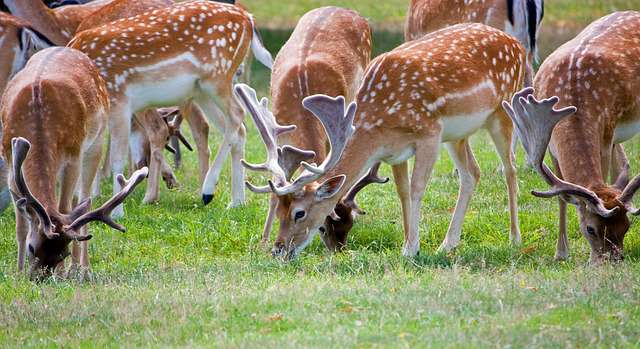Wildlife comprises all the plants, animals, and tiny living things that grow in the wild, untouched by human hands. It plays a crucial role in biodiversity. Recognizing its significance, the Government of India has initiated various wildlife conservation efforts in India.
These efforts aim to safeguard animals and nature, ensuring their existence for future generations. The collaborative approach involves people, the government, and unique strategies, combining policies, community support, and innovative ideas.
Despite facing challenges, India remains steadfast in its commitment to fostering harmony between people and wildlife. This article explores how India is actively working to preserve its natural treasures.

Project Tiger

Project Tiger is an initiative launched by the Government of India to safeguard the diminishing population of tigers and their habitats.
Commencing in 1973, it aims to address the alarming decline in tiger numbers due to habitat loss, poaching, and human-wildlife conflicts.
This project operates across various tiger reserves in the country, emphasizing the conservation and protection of this iconic species.
Objectives
- Preserve and increase the population of tigers in designated reserves.
- Protect and enhance the natural habitats of tigers.
- Mitigate factors leading to the decline of tiger populations, such as poaching and habitat destruction.
- Promote awareness and garner support for tiger conservation among local communities.
- Foster a harmonious balance between tigers, their ecosystems, and human activities.
Impacts of the Project
Population Recovery: Project Tiger has contributed significantly to the recovery of tiger populations in designated reserves, preventing the further decline of this endangered species.
Habitat Conservation: By focusing on the preservation and improvement of tiger habitats, the project has positively impacted the overall biodiversity of these ecosystems.
Community Engagement: The project’s efforts in raising awareness and involving local communities have led to increased support for tiger conservation, reducing human-wildlife conflicts.
Global Conservation Model: Project Tiger’s success has positioned it as a global model for wildlife conservation, inspiring similar initiatives in other countries facing threats to their big cat populations.
Economic Benefits: The flourishing tiger reserves attract ecotourism, providing economic benefits to local communities and further incentivizing conservation efforts.
In essence, Project Tiger stands as a testament to India’s commitment to the conservation of its rich biodiversity, particularly the majestic tiger, showcasing positive impacts on both the environment and local communities.
Project Snow Leopard

Project Snow Leopard is a one of the wildlife conservation efforts in India by the Government of India, specifically designed to safeguard the elusive and endangered snow leopards inhabiting the high-altitude regions of the country.
Launched to address the challenges faced by these magnificent big cats, the project focuses on preserving their unique habitats and ensuring coexistence with the local communities.
Objectives
Snow Leopard Population Protection: The primary goal of Project Snow Leopard is to ensure the conservation and sustainable management of snow leopard populations in their natural habitats.
Habitat Conservation: The project aims to secure the snow leopards’ habitats by implementing measures to mitigate human-wildlife conflicts, reduce habitat degradation, and promote sustainable land-use practices.
Community Involvement: Encourage the active participation of local communities in snow leopard conservation efforts by promoting awareness, providing incentives for sustainable practices, and minimizing retaliatory killings.
Biodiversity Conservation: Beyond the snow leopards, the project contributes to the conservation of the entire high-altitude ecosystem, protecting other wildlife species and their habitats.
Protected Areas
Project Snow Leopard operates in designated protected areas across the snow leopard’s natural range, including national parks, wildlife sanctuaries, and other conservation reserves.
These areas are strategically chosen to encompass the key habitats and migration corridors crucial for the survival of snow leopards.
Some notable protected areas under this initiative include the Hemis National Park in Jammu and Kashmir- specially Ladakh region, the Nanda Devi Biosphere Reserve in Uttarakhand, Kibber Wildlife Sanctuary, and the Khangchendzonga National Park in Sikkim.
Also Read: Climate Change Impact on Biodiversity
Project Cheetah

Project Cheetah is a conservation initiative undertaken by the Government of India with the aim of reintroducing the cheetah, an iconic big cat species, to its native habitats.
Inspired by successful reintroduction projects in other countries, this initiative seeks to revive the cheetah’s presence in India after its local extinction several decades ago.
Objectives
Cheetah Reintroduction: The primary goal of Project Cheetah is to reintroduce cheetahs into carefully selected and suitable habitats within India, reestablishing their presence in the country.
Biodiversity Enhancement: The project aims to contribute to the overall biodiversity of the chosen habitats by reinstating the ecological role of cheetahs and promoting a more balanced ecosystem.
Habitat Restoration: Through strategic conservation efforts, the initiative seeks to restore and conserve the natural habitats required for the survival and thriving of the reintroduced cheetah population.
Community Engagement: Foster community awareness and participation in cheetah conservation, ensuring the coexistence of cheetahs with local communities and minimizing potential conflicts.
Protected Areas
Project Cheetah identifies and designates specific protected areas for the reintroduction of cheetahs. These areas are chosen based on factors such as ecological suitability, availability of prey species, and the potential for successful adaptation of cheetahs to the local environment.
While the exact locations are subject to ongoing research and assessments, they are expected to include national parks and wildlife reserves across various states in India.
Project Elephant

Project Elephant is a dedicated initiative by the Government of India aimed at the conservation and protection of Asian elephants, recognizing their ecological importance and cultural significance.
Launched in 1992, the project addresses the challenges faced by elephants due to habitat loss, human-wildlife conflict, and other threats across various states in India.
Objectives
Habitat Conservation: The primary goal of Project Elephant is to conserve and manage the natural habitats of elephants, ensuring the preservation of their ecosystems and promoting biodiversity.
Human-Elephant Conflict Mitigation: Implement strategies to reduce conflicts between humans and elephants, protecting both communities and the well-being of the elephants.
Healthcare and Population Management: Provide veterinary care to elephants, monitor their health, and implement measures for the effective management of elephant populations in the wild.
Awareness and Community Participation: Foster awareness about elephant conservation and encourage active participation from local communities in safeguarding elephant habitats and minimizing human-elephant conflicts.
Elephant Corridors
Elephant corridors are essential components of Project Elephant, serving as dedicated pathways that connect fragmented elephant habitats.
These corridors facilitate the safe movement of elephants between different forest areas, allowing them to access vital resources, such as water and food, and maintain genetic diversity within the population.
The identification, protection, and restoration of these corridors play a crucial role in ensuring the long-term survival and well-being of elephants.
In essence, Project Elephant reflects India’s commitment to the welfare and conservation of Asian elephants, addressing the complex challenges faced by these majestic creatures while actively involving local communities in the conservation efforts.
Project Hangul

Project Hangul is an initiative by the Government of India focusing on the conservation of the Hangul, also known as the Kashmir Red Deer. This project specifically targets the preservation of this endangered species, which is native to the high-altitude regions of Jammu and Kashmir.
The Hangul is characterized by its distinctive antlers and reddish-brown coat, making it a symbol of the region’s unique biodiversity.
Objectives
Hangul Population Conservation: The primary objective of Project Hangul is to conserve and increase the population of the Hangul, which has faced a significant decline due to habitat loss, human-wildlife conflict, and other threats.
Habitat Restoration: Implement measures to restore and protect the natural habitats of the Hangul, ensuring the availability of suitable environments for their survival and reproduction.
Community Involvement: Engage local communities in the conservation efforts, raising awareness about the importance of protecting the Hangul and promoting sustainable practices to minimize human impact on their habitats.
Protection Status of Hangul
The Hangul is classified as critically endangered on the International Union for Conservation of Nature (IUCN) Red List. This status highlights the urgent need for conservation measures to prevent the further decline of the Hangul population.
The species is also protected under Schedule-I of the Wildlife Protection Act of India, providing legal safeguards against hunting and trade. Despite these protective measures, the Hangul continues to face challenges, necessitating ongoing efforts under initiatives like Project Hangul to secure its future.
In essence, Project Hangul showcases the commitment of India towards the conservation of a unique and endangered species, with a focus on both the Hangul population and its habitats.
Project One Horn Rhino

Project One Horn Rhino is a conservation initiative spearheaded by the Government of India, primarily focusing on the protection and preservation of the Indian one-horned rhinoceros.
This iconic species is native to the northeastern regions of India, particularly in the states of Assam and West Bengal. The project addresses various threats faced by the one-horned rhinoceros, including habitat loss, poaching, and human-wildlife conflicts.
Objectives
Population Conservation: The central objective of Project One Horn Rhino is to conserve and boost the population of the Indian one-horned rhinoceros, preventing further decline and ensuring the species’ survival.
Habitat Protection: Implement measures to safeguard and restore the natural habitats of the one-horned rhinoceros, focusing on the conservation of key ecosystems and biodiversity.
Anti-Poaching Efforts: Strengthen anti-poaching initiatives to curb illegal hunting and trade of rhino horns, which has been a significant threat to the one-horned rhinoceros population.
Community Engagement: Involve local communities in the conservation process, raising awareness about the importance of the one-horned rhinoceros and promoting sustainable practices to mitigate human-animal conflicts.
Protection Status of Project One Horn Rhino
The Indian one-horned rhinoceros, also known as the greater one-horned rhinoceros (Rhinoceros unicornis), is listed as a vulnerable species on the International Union for Conservation of Nature (IUCN) Red List. In addition to this global recognition, Project One Horn Rhino benefits from legal protection under Indian wildlife laws.
The species is included in Schedule I of the Wildlife Protection Act, providing stringent measures against hunting and trade. These combined efforts aim to secure the future of the Indian one-horned rhinoceros and contribute to the overall conservation of India’s rich biodiversity.
Crocodile Project

The Crocodile Project is an initiative led by the Government of India, dedicated to the conservation and management of crocodile species native to the country.
Launched to address the challenges faced by crocodiles, this project encompasses various species, including the Mugger crocodile, the Saltwater crocodile, and the Gharial. The initiative focuses on habitat protection, community involvement, and species-specific conservation strategies.
Objectives
Population Conservation: The primary goal of the Crocodile Project is to conserve and enhance the populations of native crocodile species, preventing their decline and ensuring their sustained existence in the wild.
Habitat Preservation: Implement measures to safeguard and restore the natural habitats critical for the survival of crocodile species, considering their specific ecological requirements.
Community Involvement: Engage local communities in crocodile conservation efforts, raising awareness about the importance of these species and promoting coexistence strategies to minimize human-crocodile conflicts.
Research and Monitoring: Conduct scientific research and monitoring programs to gather data on crocodile populations, behaviors, and habitat dynamics, aiding in the formulation of effective conservation strategies.
Project Sites
The Crocodile Project operates in various project sites strategically chosen to represent the diverse habitats of crocodile species across India.
Notable project sites include the Chambal River in Rajasthan and Madhya Pradesh, where the critically endangered Gharial is found, and the mangrove habitats in the coastal regions for the Saltwater crocodile.
Additionally, locations such as the wetlands and riverine ecosystems of Gujarat and Andhra Pradesh are vital project sites for the conservation of the Mugger crocodile.
Project Sea Turtle

Project Sea Turtle is a joint effort of UNDP (United Nations Development Program) and India’s Ministry of Environment, Forest, and Climate Change the project was started in 1999 at the Indian Institute of Wildlife, Dehradun to protect and preserve various species of sea turtles found along the country’s extensive coastline.
Launched to address the challenges faced by these marine reptiles, the project encompasses several species, including the Olive Ridley, Green, Hawksbill, and Loggerhead turtles. The initiative aims to ensure the sustainable existence of these sea turtles in their natural habitats.
Objectives
Nesting Site Protection: Safeguard and manage the nesting sites of sea turtles, particularly focusing on beaches where these marine reptiles lay their eggs.
Habitat Conservation: Implement measures to preserve and enhance the natural habitats critical for the survival of sea turtles, including coastal ecosystems and feeding grounds.
Community Engagement: Involve local communities in sea turtle conservation efforts, raising awareness about the importance of these species and promoting practices that reduce human impact on their habitats.
Research and Monitoring: Conduct scientific research and monitoring programs to gather data on sea turtle populations, nesting behaviors, and migration patterns, aiding in the development of effective conservation strategies.
Protection Status
Sea turtles in India are protected under various wildlife protection laws. The Olive Ridley sea turtle, for example, is listed as a vulnerable species on the International Union for Conservation of Nature (IUCN) Red List. The Wildlife Protection Act of India provides legal safeguards against the hunting, trade, and disturbance of sea turtles and their eggs.
The implementation of Project Sea Turtle reinforces these protective measures, emphasizing the importance of preserving these marine reptiles for the health of coastal ecosystems and biodiversity.
In essence, Project Sea Turtle reflects India’s commitment to the conservation of these iconic marine species, addressing habitat protection, community involvement, and research to ensure the long-term survival of sea turtles along its coasts.
Project Ganges Dolphin

Project Ganges Dolphin is an initiative initiated by the Government of India to conserve the endangered Ganges River Dolphin, a species native to the Ganges and Brahmaputra river systems.
Launched to address the challenges faced by these unique aquatic mammals, the project focuses on habitat protection, community involvement, and research to ensure the survival of the Ganges River Dolphin population.
Objectives
Habitat Conservation: Preserve and improve the natural habitats of Ganges River Dolphins, including riverine ecosystems and their associated biodiversity.
Population Protection: Enhance the population of Ganges River Dolphins, preventing further decline and promoting a sustainable coexistence between the species and their environment.
Community Engagement: Involve local communities in conservation efforts, creating awareness about the significance of Ganges River Dolphins and encouraging practices that minimize human impact on their habitats.
Research and Monitoring: Conduct scientific research and monitoring programs to gather data on Ganges River Dolphin populations, behaviors, and habitat dynamics, contributing to the development of effective conservation strategies.
Protection Status
The Ganges River Dolphin is classified as endangered on the International Union for Conservation of Nature (IUCN) Red List, signifying the urgency of conservation measures. Legal protection is provided under the Wildlife Protection Act of India, designating the Ganges River Dolphin as a Schedule I species.
This legal framework prohibits hunting, trade, and disturbance of these dolphins and their habitats. Project Ganges Dolphin reinforces these protective measures, emphasizing the importance of preserving this iconic species for the health of riverine ecosystems and biodiversity.
In essence, Project Ganges Dolphin underscores India’s commitment to the conservation of this unique aquatic mammal, addressing habitat protection, community involvement, and research to secure the long-term survival of the Ganges River Dolphin population.
Vulture Conservation

Among the wildlife conservation efforts in India vulture conservation is an essential initiative in India to protect and revive the dwindling populations of vultures. These scavengers play a crucial role in maintaining ecological balance by aiding in carcass disposal, preventing the spread of diseases.
The project addresses the threats faced by vultures, such as habitat loss, poisoning, and declining food sources.
Objectives
Population Revival: Increase vulture populations to prevent further decline and restore their ecological role.
Habitat Protection: Preserve and enhance vulture habitats, focusing on nesting and foraging areas.
Mitigate Threats: Implement measures to reduce threats like poisoning and habitat degradation.
Research and Awareness: Conduct research to understand vulture ecology and raise awareness to garner support for their conservation.
Conservation Breeding Centre
Pinjore Vulture Conservation Breeding Centre (Haryana): This breeding center focuses on breeding and reintroducing vulture species, including the critically endangered Oriental White-backed Vulture and Long-billed Vulture.
Rani Vulture Conservation Breeding Centre (Assam): Dedicated to the conservation of vultures, especially the White-rumped Vulture, this center works towards increasing their populations.
Buxa Vulture Conservation Breeding Centre (West Bengal): Focused on the conservation of vulture species, including the slender-billed vulture, this breeding center contributes to the revival efforts.
These Conservation Breeding Centers play a pivotal role in the Vulture Conservation initiative by providing a controlled environment for breeding, research, and eventual release of vultures into their natural habitats.
Importance of Wildlife Conservation Efforts and Their Impacts on Indian Wildlife
Wildlife conservation efforts hold immense importance in preserving the rich biodiversity of India. These initiatives are crucial for maintaining the ecological balance, sustaining ecosystems, and ensuring the survival of numerous plant and animal species.
By safeguarding wildlife, these efforts contribute to the overall health of the environment and promote sustainable development.
The impacts of wildlife conservation efforts on Indian wildlife are profound. Through initiatives like Project Tiger, Project Elephant, and others, endangered species receive protection, and their populations witness a positive resurgence.
Preservation of habitats, anti-poaching measures, and community involvement enhance the chances of survival for various species. These efforts also contribute to ecological harmony, prevent the loss of biodiversity, and foster a balanced coexistence between wildlife and human communities.
Conclusion
Wildlife conservation projects are not just essential; they are imperative for the well-being of our ecosystems and the survival of countless species. Projects such as Project Tiger, Project Elephant, and others play a pivotal role in reversing the decline of endangered species, protecting habitats, and promoting awareness.
The necessity of these projects cannot be overstated. They are the guardians of our natural heritage, ensuring that future generations can witness the beauty and diversity of India’s wildlife. As we acknowledge the positive impacts of these initiatives, it is crucial to recognize that more needs to be done.
A collective call to action is needed. Increased support for wildlife conservation projects, stronger policies, community involvement, and individual responsibility are essential elements in securing the future of Indian wildlife.
Together, we can continue to build on the successes of existing initiatives and forge a path towards a sustainable and harmonious coexistence between humans and wildlife in India.






